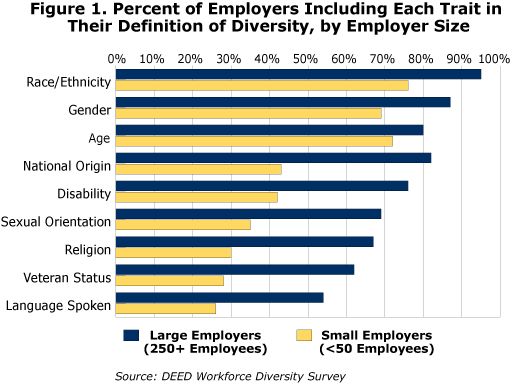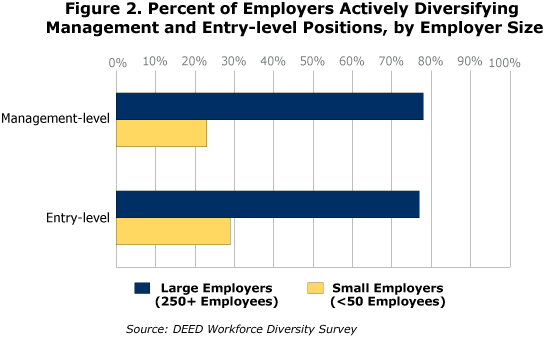by Ellen Bendewald and Scott Godfrey
March 2017
A first-of-its-kind study of Minnesota businesses found that size matters when it comes to workplace diversity.
In spring 2016, work at DEED revealed employers wanted more information on ways to successfully attract workers from communities of color. In response, DEED reached out to employers to better understand how they are approaching the issue of workforce diversity. This produced a first-of-its-kind look at workplace diversity in Minnesota.
When talking about diversity at their business or organization, 75 percent or more of employers say they are referring to race/ethnicity, gender and age. Less than one-third of employers say they are referring to concepts like personal values or beliefs, personality type or criminal background.
These tendencies differ based on the size of the employer's workforce. Employers with fewer than 50 workers are more likely to say they don't talk about diversity. When they do talk about diversity, they tend to refer to race/ethnicity, age and gender.
In contrast, employers with 250 or more workers are more likely to use a broad definition of diversity, referring to race/ethnicity, gender, national origin, age, disability, sexual orientation, religion, veteran status and language spoken (see Figure 1).

When defined as employing one or more people from communities of color, 80 percent of employers say they have a diverse workforce. Again, the size of an employer's workforce matters. About 99 percent of those employing 250 or more workers say they are diverse compared with 48 percent of employers with fewer than 50 workers.
When compared to their customer base and the residents of their community, about 60 percent of employers say their workforce is about as or more racially diverse than these groups. Around a quarter of employers say the opposite, indicating that the racial diversity of their workforce does not yet reflect the racial diversity of their community or customer base.
At both the managerial and entry levels, over 50 percent of employers say they are actively trying to increase the racial diversity of their workforces. Once again, these tendencies vary based on the size of an employer's workforce. Employers with 250 or more workers were more likely to be actively trying to increase racial diversity in both entry-level positions (77 percent compared with 29 percent) and managerial positions (78 percent compared with 23 percent) as compared to employers with fewer than 50 workers (see Figure 2).

Research has shown significant benefits from diversifying the workforce, from increased group problem-solving abilities to harder working team members.1 We hypothesized that employers who have internalized this research would also be more likely to have policies and practices intended to cultivate diversity, so first we asked why they would seek to increase the racial diversity of their workforce (see Table 1).
| Answer to" Please indicate any reasons that your business or organization would seek to increase racial diversity. Check all that apply." | |||
|---|---|---|---|
| Employer Size | |||
| Small | Medium | Large | |
| To attract the best applicants | 54% | 65% | 78% |
| To improve work environment or culture | 23% | 43% | 65% |
| To improve racial equity | 22% | 39% | 61% |
| To increase customer appeal | 15% | 26% | 42% |
| To increase employee productivity | 15% | 19% | 30% |
| Other - Write In | 5% | 10% | 14% |
| Not applicable | 18% | 10% | 6% |
| Unsure/ don't know | 20% | 9% | 3% |
| Source: DEED Workforce Diversity Survey | |||
Common in this literature are studies linking workforce diversity to higher profits or share price of large corporations and experiments on the problem-solving abilities of small groups. Missing from it is the business case for diversity among smaller employers.
Reflecting this gap in the literature, our small employer respondents are much more likely to report not knowing any reasons to increase racial diversity. The most-cited reason among employers of any size for increasing racial diversity is simply to attract the best applicants; the majority of large employers also cite improving work environment or culture and improving racial equity.
The literature on best practices in diversity management is vast but is largely theoretical and intuitive rather than evidence-based.2 At a high level, these best practices include broad recruitment strategies, mentorship and training opportunities, strong commitment from leadership, and accountability to diversity goals. We asked our employer respondents about multiple concrete strategies found in this literature, some of which do reflect a bias toward large employers (see Table 2).
| Answer to" Which of the following initiatives or practices has your business or organization engaged in within the last three years?" | |||
|---|---|---|---|
| Employer Size | |||
| Small | Medium | Large | |
| Recruitment and retention initiatives | |||
| Ensure that stated minimum qualifications are truly required and not simply preferred | 42% | 56% | 68% |
| Pay for professional development of employees | 36% | 49% | 61% |
| Make diversity training available to all employees | 13% | 32% | 53% |
| Participate in hiring events focused on people of color | 6% | 17% | 45% |
| Support a formal mentoring program among employees | 17% | 24% | 36% |
| Other | 3% | 5% | 9% |
| None of the above | 37% | 19% | 6% |
| Leadership practices | |||
| Senior leadership communicate commitment to diversity | 14% | 35% | 59% |
| Develop a clear business rationale for increased diversity | 9% | 18% | 37% |
| Devote an office, department or task force to increasing diversity | 1% | 11% | 34% |
| Include progress on diversity goals in at least one manager's job review | 1% | 9% | 29% |
| None of the above | 76% | 53% | 27% |
| Establish explicit goals for the use of women- or minority-owned suppliers | 5% | 7% | 13% |
| Source: DEED Workforce Diversity Survey | |||
Each of the strategies we ask about is more common among large employers, most of whom are re-evaluating minimum job qualifications and paying for professional development, and whose leadership is communicating a clear commitment to diversity. Small- and medium-sized employers are relatively more likely to have a formal mentoring program than to participate in hiring events focused on people of color; the opposite is true among large employers, suggesting the right mix of best practices differs by employer size.
While providing insights into the current state of workforce diversity in Minnesota, these results also raise new questions. Is there a business case for diversity that can appeal to small employers? Does successful diversity management look different for small employers than it does for large? Future research will need to address these questions to ensure employers at all levels are better prepared to benefit from Minnesota's changing workforce demographics.
MethodologyDEED Labor Market Information analysts constructed a sample from approximately 7,000 respondents to the Second Quarter 2015 Job Vacancy Survey. The sample was created to allow results to be representative of businesses of the same size, in the same region and in the same industry. The survey was administered to 3,158 employers using paper and electronic mailings and surveys. Employers with obtainable email addresses completed an online survey. All others were mailed a paper survey that included a link to complete the survey online. Employers were given five weeks to complete the survey. DEED successfully contacted 2,904 employers, of which 1,049 responded, for a response rate of 36 percent. |
1See, for instance, "How Diversity Can Drive Innovation" in the December 2013 issue of Harvard Business Review and "How Diversity Makes Us Smarter" in the Oct. 1, 2014, issue of Scientific American.
2See "Managing Diversity in Corporate America: An Exploratory Analysis" by Jefferson P. Marquis et al. from the RAND Corporation.